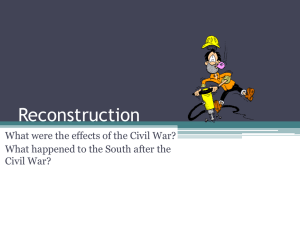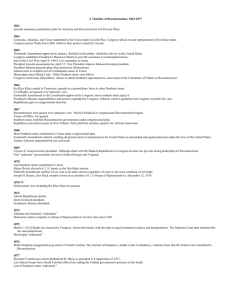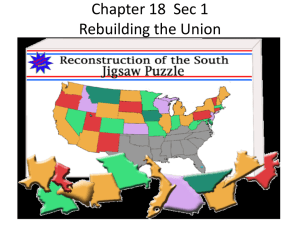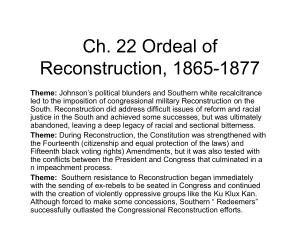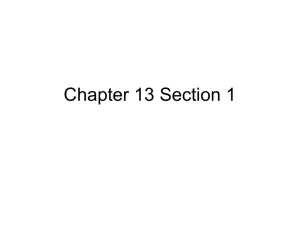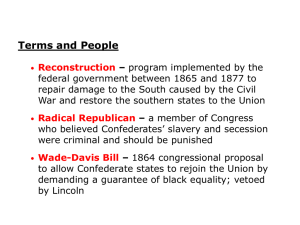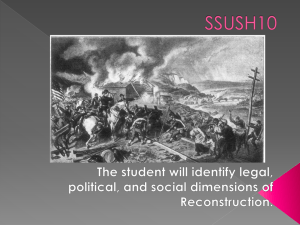Rival Plans for Reconstruction
advertisement
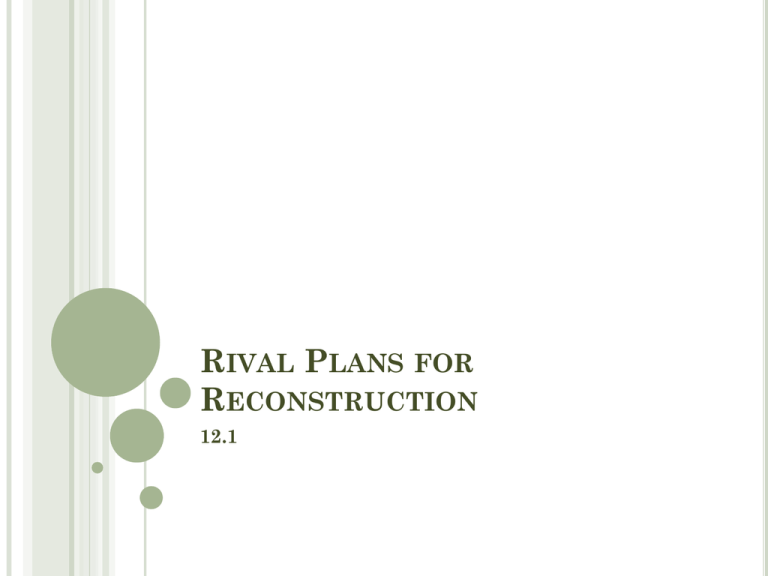
RIVAL PLANS FOR RECONSTRUCTION 12.1 OBJECTIVES Explain why a plan was needed for Reconstruction of the South. Compare the Reconstruction plans of Lincoln, Johnson, and Congress. Discuss Johnson’s political difficulties and impeachment. KEY PARTS The Issues of Reconstruction Lincoln Set a Moderate Course Johnson’s Reconstruction Plan Congressional Reconstruction INTRODUCTION Read section 12.1 Answer questions 4 and 5 THE ISSUES OF RECONSTRUCTION The era of Reconstruction was 1865-1877. The government struggled with how to return the eleven southern states to the Union, rebuild the South’s ruined economy and promote the rights of former slaves. The Constitution did not outline the process of secession or readmission of states. CONT. The Civil War devastated the South’s economy, between 1860 and 1870, the South’s share of the nations total wealth declined from more than 30% to 12%. The Union Army destroyed factories, plantations, and railroads, and nearly half of the livestock. Also ¼ of the southern men from the age of 20 to 40 were dead. CONT.. There was a large issue of what to do with the plantation land that was abandoned during the war. General William Tecumseh Sherman proposed that millions of acres should be confiscated by the government and be given to former slaves. “Give them forty acres and a mule” The south obviously didn’t agree and even the slaves said they felt they should have to pay for the land. LINCOLN SETS A MODERATE COURSE Before President Lincoln died he proposed a plan hoping to let the south back into the union easily. In 1863 he issued a Proclamation of Amnesty and reconstruction known as the Ten Percent Plan. This plan meant that once ten percent of the states voters took loyalty to the Union then they could set up a new government. CONT. The state’s constitution had to abolish slavery and provide education for African Americans to regain representation in Congress. Radicals begin to oppose the Ten Percent Plan, a group of Radical Republicans insisted that the Confederates had committed crimes and should be punished for them. Rejecting Lincoln’s Ten Percent Plan, Congress passed the Wade-Davis Bill in 1864. CONT.. President Lincoln killed this plan by “pocket veto” which means he withheld his signature beyond the ten day deadline at the end of the congressional session. One Radical Republican plan did get presidential support. The Freedmen’s Bureau was created to provide food, clothing, healthcare, and education for both black and white refugees in the South. JOHNSON RECONSTRUCTION PLAN After Lincoln’s assassination Vice President Andrew Johnson took over as President. Johnson was like Lincoln in the fact that he wanted the southern states back in the Union, however he did not care about the outcome of the African Americans. Johnson was big on states rights and made it very easy for the south to get back into the Union as long as they would accept the 13th amendment which abolished slavery. CONT. This worked for the most part except for the fact that none of the blacks were allowed to vote, become landowners, and only allowed to do certain jobs. The south developed Black Codes which were laws that sought to limit the rights of African Americans and keep the landless workers. There also was vagrancy laws that stated African Americans will be arrested if found not having employment and be forced to work as prison labor. CONT.. Both Radical and moderate Republicans were infuriated by the South’s disregard of the spirit of Reconstruction. When the southern representatives arrived in Washington, D.C. Congress refused them their seats. Congress sought to overturn the black codes by passing the Civil Rights Act of 1866. However President Johnson vetoed the act. CONGRESSIONAL RECONSTRUCTION Johnson was now openly defying Congress. For the first time ever Congress passed major legislation of over a President’s veto; which took a 2/3 majority vote. The Civil Rights Act of 1866 became law. Congress also passed the Fourteenth Amendment which guaranteed equality under the law for all citizens. Also any state that refused to allow black people to vote would risk losing the number of seats in the House of Representatives. CONT. Congress again passed legislation over Johnson’s veto with the ratification of the Military Reconstruction Act of 1867. This divided the 10 southern states that had yet to be readmitted to the Union into five military districts governed by former Union generals. The power struggle between Congress and the President reached a crisis in 1867. CONT.. The house of representatives voted to impeach Johnson in 1867. By 1868 the radicals failed by one vote to remove Johnson from office. Johnson promised to enforce the Reconstruction Acts In 1868 Ulysses S. Grant was elected President. In 1869 Congress passed the fifteenth Amendment forbidding any state from denying suffrage on the grounds of race, color or previous condition of servitude.
